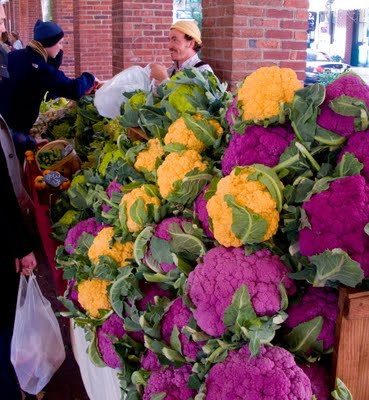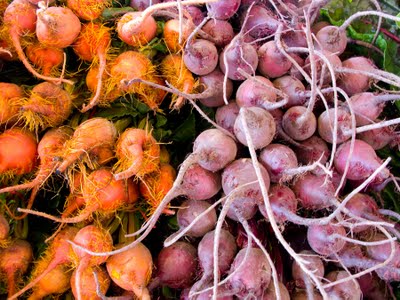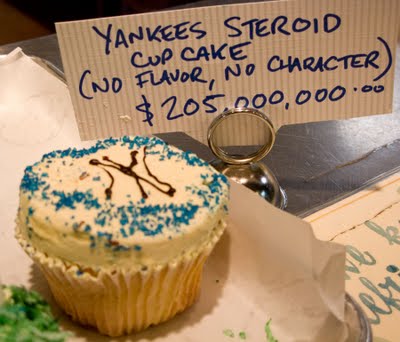Newtown Pippins
Dave Garretson of Beechwood Orchards, who sells at the Headhouse Square Farmers' Market, loves his apples, and this week he had one of the best, the Newtown Pippin.
This variety probably originated in the early 18th century in what is now the Elmhurst area of Queens, New York. (Take the Brooklyn-Queens Expressway and you'll cross Newtown Creek). It was beloved by Thomas Jefferson, Benjamin Franklin, and Queen Victoria.
The Newtown Pippin (unlike my favorite, the Cox Orange Pippin) is one of the great storage apples, which only gets better with age: I plan to delay the gratification of eating them until February, by which time their sugars will be fully formed and balance the tart, piney, citrusy, nutty flavor of this American classic; kept in cold storage with adequate air circulation (a perforated bag in your refrigerator's crisper), they'll probably keep until spring. Eat them now and you'll only get a glimmer of their complexity.
Today it's rare to find Newtown Pippins in the fresh market. Most are turned into juice, thanks to its clear, flavorful nature. If you've enjoyed Martinelli's sparking cider. you've consumed Newtown Pippins. Martinelli's purchases, at above market prices, have prevented the California plantings of Newtown Pippins from being uprooted in favor of other crops.
This revered variety was pushed out of the fresh market over the last 20 years by the Granny Smith, which offers only a hint of the wonders of the Newtown Pippin, but is more visually appealing than the frequently lopsided antique apple, whose countenance can appear marred because of natural russetting near the stem end.
In addition to California, the Newtown Pippin was a favored variety in tidewater Virginia, where the parochials renamed it the Albemarle Pippin, not wanting to keep the Yankee name. It was a major export item to England until the early 20th century when tariffs decimated that market.
Although the Newtown Pippin works well in pies, as well as apple sauce, it's highest uses are for cider and as a dessert (fresh eating) apple
Sunday, November 22, 2009
Saturday, November 21, 2009
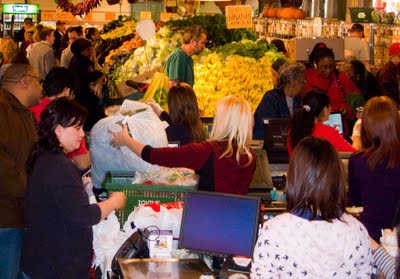 Side Dish Bargains
Side Dish BargainsThe aisles were crowded at Iovine Brother's Produce at the Reading Terminal Market this morning as shoppers sought veggies for their Thanksgiving tables. Once you managed to fight your way through the aisles, however, checkout was a snap: Jimmy and Vinnie Iovine rigged up a couple of additional registers, so there were an even dozen cashiers working.
Once reason for the crowds might have been the prices. White utility and Idaho potatoes, in five-pound bags, would set you back only $1.99. A 10-pound bag of non-Idaho russets were an even better deal, $2.99. Red potatoes were a relatively pricey, but still thrifty, $2.99 for a five-pound bag.
Onions were a good deal, too, at a buck for a two-pound bag (red or yellow). Three-pound bags of carrots were selling for two for $3. The green beans for your classic canned fried onion-topped casserole, however, were $1.99/pound, about twice as much as you'd pay at peak season. If you like some bay leaf in your stuffing, tray packs of fresh leaves were $1.99.
Among the non-Thanksgiving produce, limes have tripled in price, to 3 for $1. Hass avocados were two for $1.49.
June in November
When winter arrives, I'm a big fan of frozen fruit, particularly berries. Nothing like some tasty, sweet and tart blackberries to mash up with a full-fat yogurt for breakfast.
With its recent expansion the Fair Food Farmstand at the Reading Terminal Market has more room in its freezers, so it's added another fruit to its small frozen selection: strawberry puree. The one-pound packs from Green Meadow Farm, a delicious looking red, are priced at $5. I haven't tried them yet, but I can't imagine theyd be anything but excellent.
Another summer fruit you can enjoy in winter are peaches. Canned peaches from Three Springs Fruit Farm (one of the vendors at Headhouse) can also be found at Fair Food; I went through a few cans last winter and thoroughly enjoyed them.
When winter arrives, I'm a big fan of frozen fruit, particularly berries. Nothing like some tasty, sweet and tart blackberries to mash up with a full-fat yogurt for breakfast.
With its recent expansion the Fair Food Farmstand at the Reading Terminal Market has more room in its freezers, so it's added another fruit to its small frozen selection: strawberry puree. The one-pound packs from Green Meadow Farm, a delicious looking red, are priced at $5. I haven't tried them yet, but I can't imagine theyd be anything but excellent.
Another summer fruit you can enjoy in winter are peaches. Canned peaches from Three Springs Fruit Farm (one of the vendors at Headhouse) can also be found at Fair Food; I went through a few cans last winter and thoroughly enjoyed them.
Wednesday, November 18, 2009
Bookmark This!
Here's a description of my favorite public market that got me chuckling:
Here's a description of my favorite public market that got me chuckling:
Then I went to the Reading Terminal Market, which sounds like a sale room for old books...It comes from the blog of St. Clements Church, 20th and Cherry.
Pre-Bird Farmers' Markets
Six of The Food Trust farmers' markets will be open the day before Thanksgiving, Wednesday, Nov. 25.
Six of The Food Trust farmers' markets will be open the day before Thanksgiving, Wednesday, Nov. 25.
- Broad & South, 1 p.m. to 6 p.m.
- Clark Park, 43d and Baltimore, 10 a.m. to 4 p.m. or until vendors sell out
- Cliveden, Chew Avenue and Johnson Street, 2 p.m. to 6 p.m.
- Fairmount, 22nd Street and Fairmount, 10 a.m. to 4 p.m. or until vendors sell out
- Haddington, 52d and Haverford, 1 p.m. to 5 p.m.
- Headhouse, 10 a.m. to 4 p.m. or until vendors sell out
Tuesday, November 17, 2009
Finnan Haddie
Besides whisky, one of the Scots' great contributions to good eating is finan haddie, a.k.a. smoked haddock. Today I found some tasty examples at the Cherry Hill Wegman's, $8.99/pound for tray-packed fillets. The light smoking gives these small sides of haddock a long shelf-life; the pack I bought has a pull date of December 31.
In conversation with the knowledgeable fish manager at Wegman's, I learned these babies came from a Massachusetts supplier (New Bedford, iirc). He opened a pack so we could taste some. Haddock is a fish that needs to be lightly smoked, and the sample I tried was done right. The flesh was very firm, the pellicle lightly-colored and thin. It was smoked not quite as much as one of the classic Scottish varieties, Arbroath Smokies, but I don't find that a negative.
How to use the smoked haddock?
Since I'm fond of fish soups, Cullen Skink is one possibility. This classic Scottish milk-based chowder relies on mashed potato as its thickener, otherwise it's not at all that different from a classic New England fish chowder (done with milk, not thickened absurdly so a spoon can stand in it, as many fish house versions would have you believe).
I could also do fish on a shingle, i.e., prepare it the same way you could creamed chipped beef and serve over toast or home fries. Now that's a breakfast of champions!
Most likely I'll make a spread, mashing up the fillet with cream cheese, adding some onion, parsley and fresh ground pepper.
Sitting in the Wegman's refrigerator case next to the smoked haddock were packs of dressed and headless kippered herring. Another possibility for a champions' breakfast when served along scrambled eggs. Think of kippers as the bacon of the sea.
Besides whisky, one of the Scots' great contributions to good eating is finan haddie, a.k.a. smoked haddock. Today I found some tasty examples at the Cherry Hill Wegman's, $8.99/pound for tray-packed fillets. The light smoking gives these small sides of haddock a long shelf-life; the pack I bought has a pull date of December 31.
In conversation with the knowledgeable fish manager at Wegman's, I learned these babies came from a Massachusetts supplier (New Bedford, iirc). He opened a pack so we could taste some. Haddock is a fish that needs to be lightly smoked, and the sample I tried was done right. The flesh was very firm, the pellicle lightly-colored and thin. It was smoked not quite as much as one of the classic Scottish varieties, Arbroath Smokies, but I don't find that a negative.
How to use the smoked haddock?
Since I'm fond of fish soups, Cullen Skink is one possibility. This classic Scottish milk-based chowder relies on mashed potato as its thickener, otherwise it's not at all that different from a classic New England fish chowder (done with milk, not thickened absurdly so a spoon can stand in it, as many fish house versions would have you believe).
I could also do fish on a shingle, i.e., prepare it the same way you could creamed chipped beef and serve over toast or home fries. Now that's a breakfast of champions!
Most likely I'll make a spread, mashing up the fillet with cream cheese, adding some onion, parsley and fresh ground pepper.
Sitting in the Wegman's refrigerator case next to the smoked haddock were packs of dressed and headless kippered herring. Another possibility for a champions' breakfast when served along scrambled eggs. Think of kippers as the bacon of the sea.
Monday, November 16, 2009
Chateau de Philadelphia?
Almost. Anywhere there's an Italian community you are going to find winemakers. The grapes might not be local, but the talented winemakers are.
One of the most talented is Ralph Cipriano who won Best in Show honors at Philadelphia's Vendemmia festival. Ralph tells his wine-making journey in a new book, Garagista: A Home Winemaking Journal. The illustrated book wine chronicles the seasonal joys and labors of a Garagista (someone who makes wine in their garage).
The book starts with the Sunday dinner table at his grandparents' home, and ends with a recipe for a barrel of Zinfandel. And it's very good Zin. Or, as I call it, "Ralph's Pretty Good Wine".
Ralph Cipriano has been a reporter for more than 30 years, writing for the Philadelphia Inquirer, Los Angeles Times, and Philadelphia magazine, and is also the author of Courtroom Cowboy. His interest in homemade wine began while covering South Philadelphia as a reporter for the Inquirer. He’s made his own wine since 1992, turning it into a family enterprise that includes his wife and two sons. Ralph also competes in the annual winemaking competition at Philadelphia’s Vendemmia festival. This book details his journey from novice to Best of Show.
He'll be autographing copies this Saturday from 11 a.m. to 2 p.m. at Fante's in the Ninth Street Market. If you can't make it, you can pre-order a copy ($12.95) at Fante's web site. When you place the order on-line you can specify a dedication for the author to write into your copy.
Almost. Anywhere there's an Italian community you are going to find winemakers. The grapes might not be local, but the talented winemakers are.
One of the most talented is Ralph Cipriano who won Best in Show honors at Philadelphia's Vendemmia festival. Ralph tells his wine-making journey in a new book, Garagista: A Home Winemaking Journal. The illustrated book wine chronicles the seasonal joys and labors of a Garagista (someone who makes wine in their garage).
The book starts with the Sunday dinner table at his grandparents' home, and ends with a recipe for a barrel of Zinfandel. And it's very good Zin. Or, as I call it, "Ralph's Pretty Good Wine".
Ralph Cipriano has been a reporter for more than 30 years, writing for the Philadelphia Inquirer, Los Angeles Times, and Philadelphia magazine, and is also the author of Courtroom Cowboy. His interest in homemade wine began while covering South Philadelphia as a reporter for the Inquirer. He’s made his own wine since 1992, turning it into a family enterprise that includes his wife and two sons. Ralph also competes in the annual winemaking competition at Philadelphia’s Vendemmia festival. This book details his journey from novice to Best of Show.
He'll be autographing copies this Saturday from 11 a.m. to 2 p.m. at Fante's in the Ninth Street Market. If you can't make it, you can pre-order a copy ($12.95) at Fante's web site. When you place the order on-line you can specify a dedication for the author to write into your copy.
Sunday, November 15, 2009
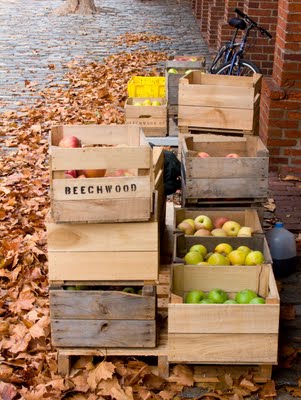 Beechwood Apple Pricing
Beechwood Apple PricingDave Garretson of Beechwood Orchard, who sells at Headhouse Square, has changed his pricing system. Until this week, he priced his fruit by the pint or quart. It was always good value, but you had to take it home and weigh it out to get a good comparison with other vendors.
Starting today he switched to strict by-the-pound pricing. His apples were $2/pound, pretty much in line with other vendors.
And he's still got Cox Orange Pippins.
Dave's only fear is that he's going to have to restrain himself when picky customers threaten to bruise the fruit next peach season.
Quality Onions
The black dirt farm country of Orange County, New York, is ideal for growing onions. And Iovine Brothers Produce has them at the Reading Terminal Market. Yesterday Iovine's was selling two-pound bags of either yellow or red onions from that growing area for $1 a bag.
Also spied at Iovine's: Chilean avocados, two for $1.49; Brussels sprouts stalks, $1.99; red bell peppers, $1.49, which was less expensive than the green, orange or yellow bells, all $1.99; limes continued to be obtainable at a dime apiece.
Brussels sprouts stalks (they called them "trees" at Iovines) were available from some of the other farm vendors: $7.50 at Fair Food, $4.95-$5.95 at Earl Livengood's.
Fair Food featured what might be the last of the seasons local tomatoes, pints of organic cherry tomatoes for $4.50. The poblano peppers, $4.50/pound, looked good.
At Kauffman's Lancaster County Produce celery stalks were $1.99 ($2.49 for hearts). Livengood's celery and celeriac were both priced at $3.95/pound.
The black dirt farm country of Orange County, New York, is ideal for growing onions. And Iovine Brothers Produce has them at the Reading Terminal Market. Yesterday Iovine's was selling two-pound bags of either yellow or red onions from that growing area for $1 a bag.
Also spied at Iovine's: Chilean avocados, two for $1.49; Brussels sprouts stalks, $1.99; red bell peppers, $1.49, which was less expensive than the green, orange or yellow bells, all $1.99; limes continued to be obtainable at a dime apiece.
Brussels sprouts stalks (they called them "trees" at Iovines) were available from some of the other farm vendors: $7.50 at Fair Food, $4.95-$5.95 at Earl Livengood's.
Fair Food featured what might be the last of the seasons local tomatoes, pints of organic cherry tomatoes for $4.50. The poblano peppers, $4.50/pound, looked good.
At Kauffman's Lancaster County Produce celery stalks were $1.99 ($2.49 for hearts). Livengood's celery and celeriac were both priced at $3.95/pound.
Forgotten Foods Remembered
Yesterday's Forgotten Foods Festival at the Reading Terminal Market opened my eyes, and tastebuds, to some old-time flavors of Philadelphia and envir0ns. By the time I left the market shortly after 11 a.m. (the festival began an hour earlier), center court was crowded with regular shoppers, the normal passel of tourists, foodies drawn by the festival, and early Christmas shoppers attracted by the Philadelphia Museum of Art's annual crafts show across the street at the Convention Center.
A particular revelation to me was the Cape May Salts, an oyster brought back from oblivion a few years ago by Atlantic Cape Fisheries, a Cape May-based company. Once upon a time the Delaware Bay was teeming with oysters, hence the proliferation in the late 19th and early 20th centurys of oyster houses in Philadelphia, once as common as today's pizza parlors, according to Atlantic Cape. In the 1950s, disease wiped out the commercial oyster industry in Delaware Bay. It took the development of disease-resistant oysters by Rutgers University and Atlantic Capes to reestablish the commercial oyster in Delaware Bay. (The Cape Mays were dispensed by the Fair Food Farmstand's Forgotten Foods stall.)
Oysters from New England, the Northeast and Mid-Atlantic are traditionally briny, but the Cape May Salts deserve their adjectival moniker more than most. The salt flavor is pronounced and delicious; these would be perfectly accompanied by a local lager, say Yuenglings or Yards.
Oysters also appeared in one of the offerings from Pearl's Oyster Bar. I've haven't eaten at Pearl's recently because previous times I'd eaten there I was disappointed: the snapper soup was way too gloppy, and the breading on the fried seafood way too doughy. That wasn't the case with what I sampled yesterday. The large, Chesapeake-style oysters in the Oyster and Chicken Salad sample was more modestly breaded and perfectly fried, the chopped chicken bound with as little mayonnaise as possible. Put them together and you've got a ying-yang food with much appeal. The little sample of Snapper Soup also was unlike what I tried previously. It might have had some corn starch to give it body, but not much. Based on these two items I'm going to give Pearl's lunch counter another try.
Old style oyster crackers -- Old Trenton Crackers -- were the media used for conveying the freshly grated horseradish offered by Hershel's East Side Deli. The pungency of the fresh grated variety is head and shoulders over the jarred imitators. Because Hershel's used an electrically-powered mechanical grater, it lacked the frisson provided by the knuckle skin that found its way into the condiment that accompanied our gefilte fish during the Pesachs of my youth.
Another revelation could be found in the black walnut cupcakes sold by Fair Food. The cupcakes, made by Flying Monkey Patisserie, used black walnuts from Green Meadow Farm, one of Fair Food's suppliers. Topped with a cream cheese-buttercream frosting, these are among the best tasting "adult" cupcake I've ever sampled.
Another dessert offered was teaberry ice cream from Bassetts. While the small cup I tasted was as creamy and rich as any produced by Bassetts, the teaberry flavor (one I always enjoyed in gum) failed to impress as an ice cream. The flavor, much like wintergreen mint, was too bubble-gummy for me, especially with its neon pink color.
The only other item I tried as the festival was the corn pudding offered by Pennsylvania General Store, made with Copes corn, a dried, toasted Pennsylvania Dutch staple. Cooked to a bread-pudding like consistency and accented with what I took to be little bits of dried fruit, this was a wonderful combination of savory and sweet. It would make a fine addition to anyone's Thanksgiving table.
Among the items I missed was the liverwurst from S&B Meats and Down Home Diner's catfish on waffles, served by Jack McDavid. If anyone can report on those items, or any other I've missed, please do!
Yesterday's Forgotten Foods Festival at the Reading Terminal Market opened my eyes, and tastebuds, to some old-time flavors of Philadelphia and envir0ns. By the time I left the market shortly after 11 a.m. (the festival began an hour earlier), center court was crowded with regular shoppers, the normal passel of tourists, foodies drawn by the festival, and early Christmas shoppers attracted by the Philadelphia Museum of Art's annual crafts show across the street at the Convention Center.
A particular revelation to me was the Cape May Salts, an oyster brought back from oblivion a few years ago by Atlantic Cape Fisheries, a Cape May-based company. Once upon a time the Delaware Bay was teeming with oysters, hence the proliferation in the late 19th and early 20th centurys of oyster houses in Philadelphia, once as common as today's pizza parlors, according to Atlantic Cape. In the 1950s, disease wiped out the commercial oyster industry in Delaware Bay. It took the development of disease-resistant oysters by Rutgers University and Atlantic Capes to reestablish the commercial oyster in Delaware Bay. (The Cape Mays were dispensed by the Fair Food Farmstand's Forgotten Foods stall.)
Oysters from New England, the Northeast and Mid-Atlantic are traditionally briny, but the Cape May Salts deserve their adjectival moniker more than most. The salt flavor is pronounced and delicious; these would be perfectly accompanied by a local lager, say Yuenglings or Yards.
Oysters also appeared in one of the offerings from Pearl's Oyster Bar. I've haven't eaten at Pearl's recently because previous times I'd eaten there I was disappointed: the snapper soup was way too gloppy, and the breading on the fried seafood way too doughy. That wasn't the case with what I sampled yesterday. The large, Chesapeake-style oysters in the Oyster and Chicken Salad sample was more modestly breaded and perfectly fried, the chopped chicken bound with as little mayonnaise as possible. Put them together and you've got a ying-yang food with much appeal. The little sample of Snapper Soup also was unlike what I tried previously. It might have had some corn starch to give it body, but not much. Based on these two items I'm going to give Pearl's lunch counter another try.
Old style oyster crackers -- Old Trenton Crackers -- were the media used for conveying the freshly grated horseradish offered by Hershel's East Side Deli. The pungency of the fresh grated variety is head and shoulders over the jarred imitators. Because Hershel's used an electrically-powered mechanical grater, it lacked the frisson provided by the knuckle skin that found its way into the condiment that accompanied our gefilte fish during the Pesachs of my youth.
Another revelation could be found in the black walnut cupcakes sold by Fair Food. The cupcakes, made by Flying Monkey Patisserie, used black walnuts from Green Meadow Farm, one of Fair Food's suppliers. Topped with a cream cheese-buttercream frosting, these are among the best tasting "adult" cupcake I've ever sampled.
Another dessert offered was teaberry ice cream from Bassetts. While the small cup I tasted was as creamy and rich as any produced by Bassetts, the teaberry flavor (one I always enjoyed in gum) failed to impress as an ice cream. The flavor, much like wintergreen mint, was too bubble-gummy for me, especially with its neon pink color.
The only other item I tried as the festival was the corn pudding offered by Pennsylvania General Store, made with Copes corn, a dried, toasted Pennsylvania Dutch staple. Cooked to a bread-pudding like consistency and accented with what I took to be little bits of dried fruit, this was a wonderful combination of savory and sweet. It would make a fine addition to anyone's Thanksgiving table.
Among the items I missed was the liverwurst from S&B Meats and Down Home Diner's catfish on waffles, served by Jack McDavid. If anyone can report on those items, or any other I've missed, please do!
Sunday, November 08, 2009
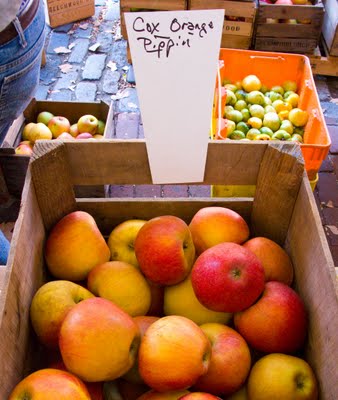 Apple
Appleof My Eye
I've been telling Dave Garretson of Beechwood Orchards about Cox Orange Pippins for a couple of years now. This week he found some on a neighbor's orchard and brought them to Headhouse Square.
Although these apples were picked about a month ago and have been in storage, they've hardly lost anything. Indeed, this variety ripens best after picking. Cox Orange Pippins are only moderately crisp (those who insist on absolutely crunchy crispness will be disappointed), but their flavor is second to none, with a perfect balance of sweetness and tartness. Many believe, as I do, that it's the world's finest dessert apple, i.e., for eating uncooked. It's no wonder that Cox Orange Pippins are the most popular apple in the U.K., so much so that they're imported from South Africa in the off-season. (Alas, because they are more susceptible to disease, it's likely to lose this distinction soon, as more growers shift to other varieities.)
This variety first appeared in 1825 in England. And if you think the taste is vaguely familiar, you aren't imagining it. Today's Gala apple is a less flavorful but hardier descendant.
Tom Culton, shown today behind his Headhouse Farmers' Market stand laden with colorful cauliflower, loves produce in all its varieties. So much so that, according to an article in Citypaper this week, he raises 63 varieties of garlic. Read it here.
Transit Strike Hurts RTM
At least some merchants and the Reading Terminal Market have seen business fall off dramtically due to the SEPTA strike.
One of Iovine Brothers Produce's managers said volume was off 40 percent. On top of that, he and fellow managers had become a de facto taxi service, driving employees to and from work.
Other merchants saw lesser impacts. Over at the Fair Food Farmstand, while business was off a little, it wasn't devastating.
At least some merchants and the Reading Terminal Market have seen business fall off dramtically due to the SEPTA strike.
One of Iovine Brothers Produce's managers said volume was off 40 percent. On top of that, he and fellow managers had become a de facto taxi service, driving employees to and from work.
Other merchants saw lesser impacts. Over at the Fair Food Farmstand, while business was off a little, it wasn't devastating.
Save the Deli!
I'm only about a quarter into this book dedicated to the Jewish deli, but it is fascinating. Although author David Sax may have omitted reference to your favorite deli, anyone who enjoys a good pastrami sandwich or plate of kishke will say a b'rucha for this book.
I purchased the book last Tuesday at a signing in connection with Sax's appearance in the Free Library of Philadelphia's author series. Coincidentally, Tuesday was National Sandwich Day, the birthday of John Montague, reputed to be the inventor of the sandwich. (A blatant lie.)
In his talk, Sax outlined the two primary reasons why the Jewish deli is in such serious decline (from a couple thousand in the early part of the century in New York City to maybe a couple hundred today).
The first reason is simple economics. The traditional foods served by the deli have very high material costs. The margin on that $9 or $14 pastrami sandwich will be a buck at best. Add in high rents (especially in Manhattan) and labor costs and you've got a business challenge of the first order.
The second reason -- and the one Sax spent most of his time discussing -- is culture. He quickly touched on a variety of cultural reasons for the deli's decline (generational change, changes in food tastes, etc.), but I found one particularly interesting: No homeland for keeping the tradition alive. For example, the reason why Italian restaurants are still going strong, even though changes in U.S. immigration law largely shut off the Italians as much as the Jews in 1920, is that there is still an Italy with a thriving, evolving food culture. Same goes for the various Asian cuisines and just about any other ethnic cuisine you can think of. Not so Ashkenazi Jewish cuisine: the Holocaust wiped out the Ashkenazi Jews of Europe and, with it, the natural homeland of their cookery.
That's not true of the style of Jewish cuisine that has most recently taken root and thrived in America, Israeli/Middle Eastern cooking. Falafel stands are ubiquitous, as Israelis migrate to the U.S. and open restaurants offering their home cooking, as reinterpreted here in America. Because there is an Israel with its own cooking traditions (albeit, adapted from Arabic cultures, just as Ashkenazi cooking adapted from Polish, Germany, French and other european cultures), there is a living base from which to grow.
In his Philadelphia talk, Sax offered a number of possible solutions -- including his belief that delis should eschew buying finished corned beer and pastrami from the large processors, like Hebrew National (a unit of Conagra), and instead cure their own meats and make everything they can on premises. Since he was speaking in Philadelphia, he singled at Hershel's East Side Deli in the Reading Terminal Market as a fine example. (That's where he lunched.)
Sax is definitely going to be a big hit at all the pre-Hanukah Jewish Book Fairs around North America. The fact that he's from Toronto and has a passion for Montreal smoked meat, you shouldn't against him hold.
David's web site: Save the Deli
I'm only about a quarter into this book dedicated to the Jewish deli, but it is fascinating. Although author David Sax may have omitted reference to your favorite deli, anyone who enjoys a good pastrami sandwich or plate of kishke will say a b'rucha for this book.
I purchased the book last Tuesday at a signing in connection with Sax's appearance in the Free Library of Philadelphia's author series. Coincidentally, Tuesday was National Sandwich Day, the birthday of John Montague, reputed to be the inventor of the sandwich. (A blatant lie.)
In his talk, Sax outlined the two primary reasons why the Jewish deli is in such serious decline (from a couple thousand in the early part of the century in New York City to maybe a couple hundred today).
The first reason is simple economics. The traditional foods served by the deli have very high material costs. The margin on that $9 or $14 pastrami sandwich will be a buck at best. Add in high rents (especially in Manhattan) and labor costs and you've got a business challenge of the first order.
The second reason -- and the one Sax spent most of his time discussing -- is culture. He quickly touched on a variety of cultural reasons for the deli's decline (generational change, changes in food tastes, etc.), but I found one particularly interesting: No homeland for keeping the tradition alive. For example, the reason why Italian restaurants are still going strong, even though changes in U.S. immigration law largely shut off the Italians as much as the Jews in 1920, is that there is still an Italy with a thriving, evolving food culture. Same goes for the various Asian cuisines and just about any other ethnic cuisine you can think of. Not so Ashkenazi Jewish cuisine: the Holocaust wiped out the Ashkenazi Jews of Europe and, with it, the natural homeland of their cookery.
That's not true of the style of Jewish cuisine that has most recently taken root and thrived in America, Israeli/Middle Eastern cooking. Falafel stands are ubiquitous, as Israelis migrate to the U.S. and open restaurants offering their home cooking, as reinterpreted here in America. Because there is an Israel with its own cooking traditions (albeit, adapted from Arabic cultures, just as Ashkenazi cooking adapted from Polish, Germany, French and other european cultures), there is a living base from which to grow.
In his Philadelphia talk, Sax offered a number of possible solutions -- including his belief that delis should eschew buying finished corned beer and pastrami from the large processors, like Hebrew National (a unit of Conagra), and instead cure their own meats and make everything they can on premises. Since he was speaking in Philadelphia, he singled at Hershel's East Side Deli in the Reading Terminal Market as a fine example. (That's where he lunched.)
Sax is definitely going to be a big hit at all the pre-Hanukah Jewish Book Fairs around North America. The fact that he's from Toronto and has a passion for Montreal smoked meat, you shouldn't against him hold.
David's web site: Save the Deli
Tuesday, November 03, 2009
 The Commish
The CommishVisits the Deli
Bud Selig, MLB commissioner, stopped for lunch at the Reading Terminal Market Monday, ordering a sandwich at Hershel's Deli. He stopped by last year, too.
Selig is shown here with Steve Safron of Hershel's.
The RTM's general manager, Paul Steinke, remarked when he passed along the photo: "Guess he can’t get good corned beef in Milwaukee!"
No, you can't. Decent custard, burekas and wursts, but not corned beef or pastrami. Not even in Whitefish Bay, Milwaukee's predominantly Jewish suburb.
Sunday, November 01, 2009
Farmers' Markets Winding Down
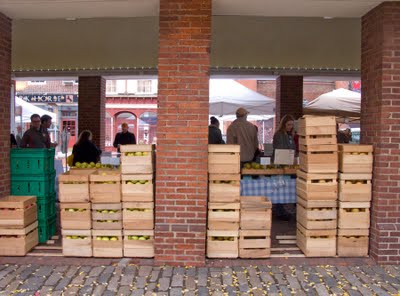 Many of the region's farmers' markets have closed down for the season, but a number are still going strong.
Many of the region's farmers' markets have closed down for the season, but a number are still going strong.
The Food Trust's Sunday market at Headhouse Square and Thursday market at Clark Park will continue through the week before Christmas. Both will be open the day before Thanksgiving, but closed the following weekend. They'll then continue in December until Christmas. Clark Park's Saturday market will continue year-round.
At Headhouse today, remaining produce vendors included Blooming Glen, Beechwood Orchads, North Star Orchards (photo), Weaver's Way, Three Springs Fruit Farm, Margerum's, Culton Organics, Queens Farm and Savoie Farm. Dark, leafy greens were particularly attractive at a number of the stands, and North Star, Beechwood and Three Spruings offered a nice variety of apples; Beechwood also was selling quinces ($5 quart) for those of you into apple pie making. Cabbages and other brassicas (turnips, brussells sprouts, cauliflower and romansco) were also prevalent. In addition to its usual fine selection of heirloom potatoes, Savoie featured some good looking lettuces.
 Many of the region's farmers' markets have closed down for the season, but a number are still going strong.
Many of the region's farmers' markets have closed down for the season, but a number are still going strong.The Food Trust's Sunday market at Headhouse Square and Thursday market at Clark Park will continue through the week before Christmas. Both will be open the day before Thanksgiving, but closed the following weekend. They'll then continue in December until Christmas. Clark Park's Saturday market will continue year-round.
At Headhouse today, remaining produce vendors included Blooming Glen, Beechwood Orchads, North Star Orchards (photo), Weaver's Way, Three Springs Fruit Farm, Margerum's, Culton Organics, Queens Farm and Savoie Farm. Dark, leafy greens were particularly attractive at a number of the stands, and North Star, Beechwood and Three Spruings offered a nice variety of apples; Beechwood also was selling quinces ($5 quart) for those of you into apple pie making. Cabbages and other brassicas (turnips, brussells sprouts, cauliflower and romansco) were also prevalent. In addition to its usual fine selection of heirloom potatoes, Savoie featured some good looking lettuces.
Forgotten Foods at RTM
Forgotten foods of the region will be the focus of a festival at the Reading Terminal Market on Saturday, Nov. 14, from 10 a.m. to 4 p.m.
A number of merchants will be preparing some of these foods from our past, and they'll all be available for tasting at reasonable cost. (You'll probably buy tickets at a central point, then exchange the tickets for the tastes.)
Among the featured foods:
Dominic Spataro, whose sandwich shop has been a presence at the market for decades, said fresh grated horseradish brings back fond market memories for him. Nearly half a century ago a merchant named Franklin Field made it on premises for sale at the predecessor to today's Spice Terminal, where he also offered fresh grated coconut. His granted both by hand on a tool used by carpenters to bevel latticework, wearing a leather apron to protect himself from injury Another of Field's products that was quite popular was Irish dulse (seaweed). The tradition continued when Field's stall was taken over by Harvey Riley, who ran it until it closed in the late 1970s. The spice shop was located near where Iovine Brothers Produce stands today.
Poses: The Commissary At Home
Steve Poses, remembered by many as one of the movers creating Philadelphia's Restaurant Renaissance in the 1970s and 1980s through his Commissary restaurant, has spent his efforts since then with his catering business. Now he's published a book about home entertaining, At Home: A Caterer's Guide to Cooking & Entertaining.
Poses will be in the Piano Court next Saturday, Nov. 7, from 11 a.m. to 2 p.m. promoting the book and its companion web site and sharing his expertise and passion for home entertaining. He’ll present mini-courses designed to help plan a delicious and stress-free Thanksgiving. The book, usually sold only online (www.athomebysteveposes) will also be available for purchase.
Forgotten foods of the region will be the focus of a festival at the Reading Terminal Market on Saturday, Nov. 14, from 10 a.m. to 4 p.m.
A number of merchants will be preparing some of these foods from our past, and they'll all be available for tasting at reasonable cost. (You'll probably buy tickets at a central point, then exchange the tickets for the tastes.)
Among the featured foods:
- Copes Dried Corn, Wilbur Buds (the original from which Hershey derived his kisses), and Buttercreams from Pennsylvania General Store.
- Fried Catfish and Waffles, Pepperpot Soup from the Down Home Diner.
- Pepper Hash from AJ's Pickles.
- Fried Oysters from Pearl's served with Chicken Salad (probably from Hershel's).
- Snapper Soup from Pearl's.
- Cape May Salt Oysters, Cranberries and Black Walnuts from Fair Food Farmstand.
- Fresh Grated Horseradish from Hershel's.
Dominic Spataro, whose sandwich shop has been a presence at the market for decades, said fresh grated horseradish brings back fond market memories for him. Nearly half a century ago a merchant named Franklin Field made it on premises for sale at the predecessor to today's Spice Terminal, where he also offered fresh grated coconut. His granted both by hand on a tool used by carpenters to bevel latticework, wearing a leather apron to protect himself from injury Another of Field's products that was quite popular was Irish dulse (seaweed). The tradition continued when Field's stall was taken over by Harvey Riley, who ran it until it closed in the late 1970s. The spice shop was located near where Iovine Brothers Produce stands today.
Poses: The Commissary At Home
Steve Poses, remembered by many as one of the movers creating Philadelphia's Restaurant Renaissance in the 1970s and 1980s through his Commissary restaurant, has spent his efforts since then with his catering business. Now he's published a book about home entertaining, At Home: A Caterer's Guide to Cooking & Entertaining.
Poses will be in the Piano Court next Saturday, Nov. 7, from 11 a.m. to 2 p.m. promoting the book and its companion web site and sharing his expertise and passion for home entertaining. He’ll present mini-courses designed to help plan a delicious and stress-free Thanksgiving. The book, usually sold only online (www.athomebysteveposes) will also be available for purchase.
Save the Deli
There will be a bit of show and tell when author David Sax visits the Free Public Library Tuesday evening to promote his book, Save the Deli. A couple of local delis will be providing noshes, including pastrami of Hershel's Deli of the Reading Terminal Market. The program is free and begins at 7:30 p.m. at the Central Library, 19th and Vine.
There will be a bit of show and tell when author David Sax visits the Free Public Library Tuesday evening to promote his book, Save the Deli. A couple of local delis will be providing noshes, including pastrami of Hershel's Deli of the Reading Terminal Market. The program is free and begins at 7:30 p.m. at the Central Library, 19th and Vine.
Subscribe to:
Posts (Atom)

